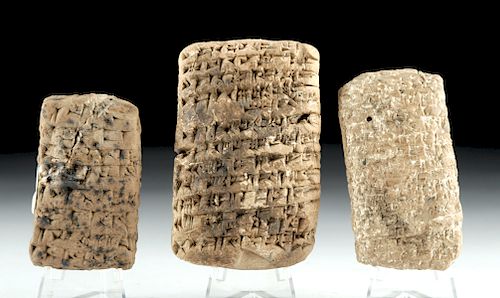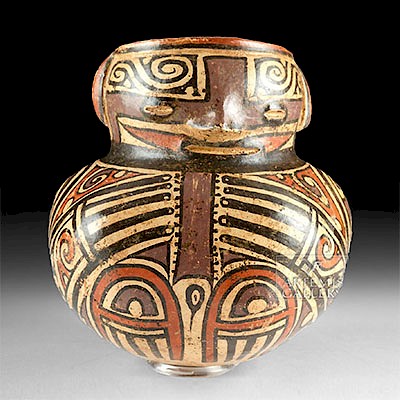Lot of 3 Mesopotamian Clay Cuneiform Tablets
Lot 37b
About Seller
Artemis Fine Arts
686 S Taylor Ave, Ste 106
Louisville, CO 80027
United States
Selling antiquities, ancient and ethnographic art online since 1993, Artemis Gallery specializes in Classical Antiquities (Egyptian, Greek, Roman, Near Eastern), Asian, Pre-Columbian, African / Tribal / Oceanographic art. Our extensive inventory includes pottery, stone, metal, wood, glass and textil...Read more
Estimate:
$2,000 - $3,500
Absentee vs Live bid
Two ways to bid:
- Leave a max absentee bid and the platform will bid on your behalf up to your maximum bid during the live auction.
- Bid live during the auction and your bids will be submitted real-time to the auctioneer.
Bid Increments
| Price | Bid Increment |
|---|---|
| $0 | $25 |
| $300 | $50 |
| $1,000 | $100 |
| $2,000 | $250 |
| $5,000 | $500 |
| $10,000 | $1,000 |
| $20,000 | $2,500 |
| $50,000 | $5,000 |
| $100,000 | $10,000 |
| $200,000 | $20,000 |
About Auction
By Artemis Fine Arts
Nov 8, 2018
Set Reminder
2018-11-08 10:00:00
2018-11-08 10:00:00
America/New_York
Bidsquare
Bidsquare : Ancient / Ethnographic From Around The World
https://www.bidsquare.com/auctions/artemis-gallery/ancient-ethnographic-from-around-the-world-3598
Ancient art from Egypt, Greece, Italy and the Near East, as well as Asian, Pre-Columbian, Native American, African / Tribal / Oceanic, Spanish Colonial, Russian Icons, Fine art, much more! Artemis Fine Arts info@artemisgallery.com
Ancient art from Egypt, Greece, Italy and the Near East, as well as Asian, Pre-Columbian, Native American, African / Tribal / Oceanic, Spanish Colonial, Russian Icons, Fine art, much more! Artemis Fine Arts info@artemisgallery.com
- Lot Description
Ancient Near East, Mesopotamia, Old Babylonian Period, ca. 1900 to 1700 BCE. A group of three hand-built clay administrative tablets with rectangular forms and convex faces. The tablets contain eighteen, thirty-two, and seventeen lines of inscribed cuneiform characters - from smallest to largest, respectively - which are made by impressing a sharpened reed or stick into the still-wet clay just prior to being placed inside a kiln. The smallest tablet is untranslated. Though incomplete, the translation of the medium-sized tablet concerns a shipment of 12 minas of silver (one mina weighed between 640 grams [about 23 ounces] to 978 grams [about 34 ounces]). The translation of the largest tablet, though also incomplete, records the sizes of 12 fields which were assigned to named men, presumably government officials. It is dated to the 30th day, month 6 of the accession year of King Nur-Adad of Larsa. Lucite display stands for photography purposes only. Size of largest (Nur-Adad): 2.25" W x 3.625" H (5.7 cm x 9.2 cm).
Provenance: private East Coast, USA collection
All items legal to buy/sell under U.S. Statute covering cultural patrimony Code 2600, CHAPTER 14, and are guaranteed to be as described or your money back.
A Certificate of Authenticity will accompany all winning bids.
We ship worldwide and handle all shipping in-house for your convenience.
#137757All tablets have small repairs with minor losses and light adhesive residue along break lines. Each tablet has minor nicks to faces and peripheries, fading to inscribed cuneiform characters, and light encrustations or mineral deposits. Nice earthen deposits throughout.Condition
- Shipping Info
-
All shipping is handled in-house for your convenience. Your invoice from Artemis Gallery will include shipping calculation instructions. If in doubt, please inquire BEFORE bidding for estimated shipping costs for individual items.
-
- Buyer's Premium



 EUR
EUR CAD
CAD AUD
AUD GBP
GBP MXN
MXN HKD
HKD CNY
CNY MYR
MYR SEK
SEK SGD
SGD CHF
CHF THB
THB













